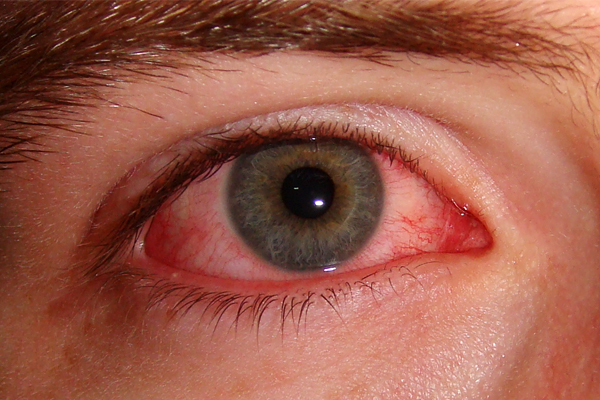
The term “pink eye” refers to ocular redness caused by inflammation to the eye or its surrounding tissues, such as the eyelids and the membrane lining the inner recesses of the eyelids (conjunctivae). Also known as conjunctivitis, this inflammation is usually the result of infection (most common) or other conditions such as allergies, injury or chemical irritation.
Pink eye is the most common eye (ocular) infection of childhood. It may occur at any age. When the cause is from infection it is considered highly contagious to others who come into contact with these individuals.
Typical signs and symptoms are obvious redness of the eye itself or surrounding tissues, drainage of fluid from the adjacent eye structures, swelling, pain, irritation, itching and sometimes light sensitivity. Pink eye may occur either by itself or in conjunction with a respiratory illness, such as a common cold. A careful history may support a diagnosis of injury or allergies. When it comes to infection, the cause may be bacteria, such as Staphylococcus or Streptococcus, or a common cold virus.
Age is a very important factor. For example, the neonatal child (especially less than 3 months of age) requires urgent attention because of the possibility of more dangerous germs which can threaten a child’s vision and indicate an underlying, potentially life-threatening infection. The diagnosis is primarily clinical, but sometimes a more detailed investigation may be required, including a culture taken of the draining fluid surrounding the eye.
Contact lens wearers may be vulnerable to complications from simple infections. Suspected injuries require their own specific exam by a health care provider experienced in treating those conditions.
Treatment depends upon the cause. Ocular antibiotic drops, ointment and sometimes oral antibiotics are often prescribed for between 4-7 days. In most cases the infections are not serious and readily respond to medication and cool compresses over the affected eye. Sometimes additional follow up is required with an eye specialist.
There is a special emphasis on frequent hand washing to prevent the continued spread of infection. Contact lens wearers should also be advised to avoid artificial lenses while being treated to avoid complications, such as ulcerations on the cornea layer (the clear outermost membrane) of the eye.
To keep a sharp focus, don’t ignore unexplained eye inflammation. See your doctor or urgent care physician as soon as possible.
We're here when you need us, at two locations. You can even check online--before you go--to see the number of patients waiting at either location.
'Til next time,
Dr. Brian J. Coté
Pink eye is the most common eye (ocular) infection of childhood. It may occur at any age. When the cause is from infection it is considered highly contagious to others who come into contact with these individuals.
Typical signs and symptoms are obvious redness of the eye itself or surrounding tissues, drainage of fluid from the adjacent eye structures, swelling, pain, irritation, itching and sometimes light sensitivity. Pink eye may occur either by itself or in conjunction with a respiratory illness, such as a common cold. A careful history may support a diagnosis of injury or allergies. When it comes to infection, the cause may be bacteria, such as Staphylococcus or Streptococcus, or a common cold virus.
Age is a very important factor. For example, the neonatal child (especially less than 3 months of age) requires urgent attention because of the possibility of more dangerous germs which can threaten a child’s vision and indicate an underlying, potentially life-threatening infection. The diagnosis is primarily clinical, but sometimes a more detailed investigation may be required, including a culture taken of the draining fluid surrounding the eye.
Contact lens wearers may be vulnerable to complications from simple infections. Suspected injuries require their own specific exam by a health care provider experienced in treating those conditions.
Treatment depends upon the cause. Ocular antibiotic drops, ointment and sometimes oral antibiotics are often prescribed for between 4-7 days. In most cases the infections are not serious and readily respond to medication and cool compresses over the affected eye. Sometimes additional follow up is required with an eye specialist.
There is a special emphasis on frequent hand washing to prevent the continued spread of infection. Contact lens wearers should also be advised to avoid artificial lenses while being treated to avoid complications, such as ulcerations on the cornea layer (the clear outermost membrane) of the eye.
To keep a sharp focus, don’t ignore unexplained eye inflammation. See your doctor or urgent care physician as soon as possible.
We're here when you need us, at two locations. You can even check online--before you go--to see the number of patients waiting at either location.
'Til next time,
Dr. Brian J. Coté
Healthy Life Category